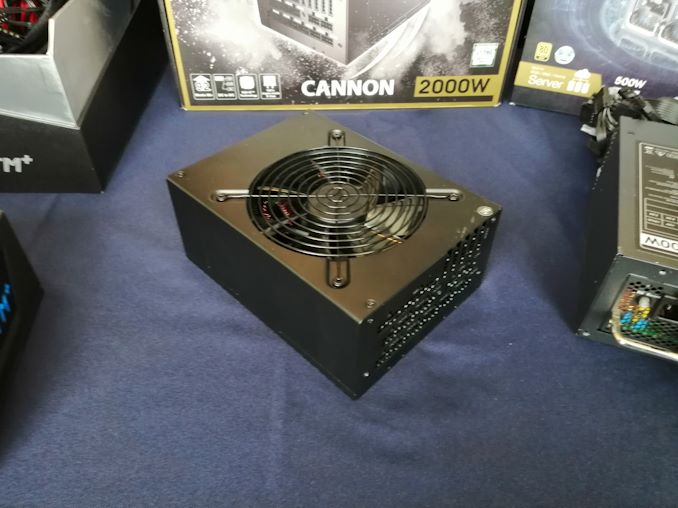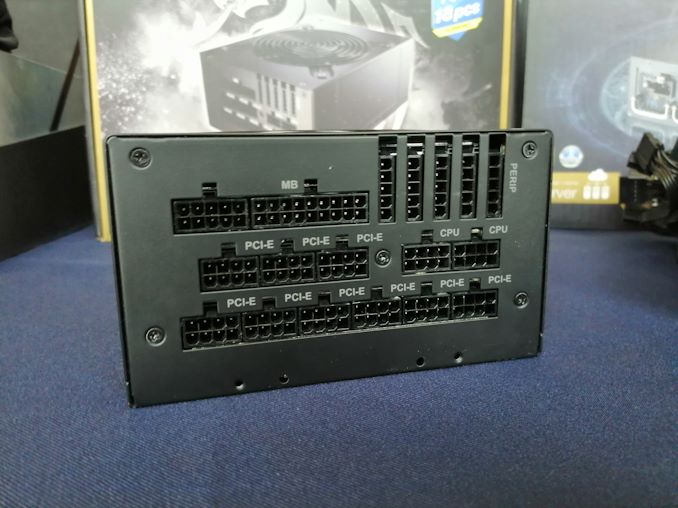CES 2019: FSP's Cannon 2000 Watt Power Supply
by Ian Cutress on January 10, 2019 10:00 AM EST- Posted in
- Cases/Cooling/PSUs
- PSUs
- FSP
- Trade Shows
- Cannon
- CES 2019

When you build a cannon of a system, perhaps with dual processors and four graphics cards and lots of RGB, then something needs to power it. FSP has just the product for you: the Cannon 2000W power supply.
We've seen power supplies this high in the consumer market before, and this is FSP's take. They originally built it for the mining market, and since that market has essentially dried up in recent months, the company is pitching it further afield. The unit is built on a single rail design, and adheres to ATX spec (210mm long), and has passed certification for 80 PLUS Gold, which guarantees 87% efficiency at 20% load, 90% efficiency at 50% load, and 87% efficiency at 100%. That last figure means that at a full 2000W, the system could be losing as much as 260W due to power losses. The power supply needs good cooling too.
The Cannon 2000W is already available in some markets, priced at $400.












12 Comments
View All Comments
PeachNCream - Thursday, January 10, 2019 - link
Can household wiring handle that sort of wattage? I blow circuits and have to got into my rental's yucky, creepy basement to reset them if I run my microwave and a blow dryer at the same time for more than a couple of minutes and my microwave is only 700W.namechamps - Thursday, January 10, 2019 - link
Not on a "standard" US 120V circuit. It would be at most 1800W on a standard 120V, 15A circuit. Realistically unless it is a dedicated circuit for that outlet there are likely other loads.uibo - Thursday, January 10, 2019 - link
If you look at the picture, it actually says 1500W@115-200Vac 1200W@110-115Vacnevcairiel - Thursday, January 10, 2019 - link
Yeah only rated for 2000W at ~230V input. Not that I would buy one, but if I wanted to, I could, and use its 2000W potential here in the EU.DanNeely - Thursday, January 10, 2019 - link
IMO this actually makes it worse. This lets them get away with shipping it with a NEMA 5-15 plug which can't deliver the headline power number; instead of a 5-20 plug that can draw 20A @115V and deliver the headline number.If the device actually has a 300W discontinuity at 115V it's even worse as slight but permissible fluctuations in the US power grid voltage could cause the output to abruptly drop below what the system is currently drawing and crash it.
repoman27 - Thursday, January 10, 2019 - link
I think they were trying to cover as many regions as possible with a single design, seeing as the market for this thing will be pretty niche. The IEC C20 receptacle on the PSU itself is technically only rated for 16 A, and it can’t know whether the plug at the other end of the cable is NEMA 5-15P, 5-20P, or something else entirely.I’m pretty sure the nameplate voltage levels here are essentially attempting to differentiate between Japan, US, and Europe. And they’ve limited power output to the max continuous load for typical 15 A circuits / receptacles in Japan and the US (1200 and 1500 W respectively). I doubt it would suddenly switch down to Japanese levels when connected to US mains under normal circumstances.
uibo - Thursday, January 10, 2019 - link
If you look at the picture, it actually says 1500W@115-200Vac 1200W@100-115Vacdanjw - Sunday, January 13, 2019 - link
Depends on when the house was built. Most new homes today come with 20A breakers. Older homes come with 15A breakers. So, it really depends on when the house was built and/or if the electrical system has been upgraded.namechamps - Thursday, January 10, 2019 - link
Yeah that is a pointless product if I ever saw one. Better to get a more platinum PSU with a more reasonable peak load. These days even with a workstation board and dual CPUs and dual GPUs you would be hard pressed to use more than 1000W.nevcairiel - Thursday, January 10, 2019 - link
The only people that realistically would get a PSU like this are people either running 4 high-end GPUs (at 300W each, or such), or hardcore overclockers where single components can start to draw a lot of power and they might otherwise use two PSUs even.Its not useful for any "ordinary" enthusiast or workstation user.